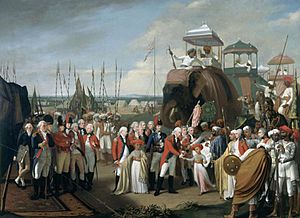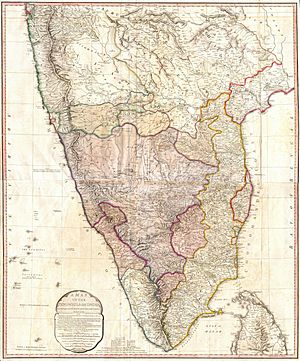Treaty of Seringapatam facts for kids
The Treaty of Seringapatam was an important agreement signed on March 18, 1792. It officially ended the Third Anglo-Mysore War. This treaty was signed by Lord Cornwallis for the British East India Company. Also signing were representatives from the Nizam of Hyderabad and the Maratha Empire, along with Tipu Sultan, who was the ruler of Mysore.
Why the Treaty Was Needed
The war that led to this treaty started in late 1789. Tipu Sultan, the ruler of Mysore, attacked Travancore. Travancore was a friend and ally of the British East India Company.
After more than two years of fighting, forces led by Lord Cornwallis from the British East India Company, along with their allies from the Maratha Empire and Hyderabad, surrounded Mysore's capital city, Seringapatam. This happened in February 1792.
Instead of a costly battle to take the city, Lord Cornwallis decided to talk with Tipu Sultan. They wanted to find a way to end the conflict peacefully. The talks led to the treaty being signed on March 18.
Lord Cornwallis hoped this treaty would bring a lasting peace. He wanted it to reduce the threat from Mysore and also prevent future fights between Hyderabad and the Marathas. However, the Marathas did not want these extra rules included in the treaty.
What the Treaty Decided
Under the terms of the treaty, Mysore had to give up about half of its lands. These lands were divided among the other groups who signed the treaty.
- The Peshwa (a leader of the Maratha Empire) received land up to the Tungabhadra River.
- The Nizam of Hyderabad was given land from the Krishna River to the Penner River. He also received the forts of Cuddapah and Gandikota.
- The British East India Company gained a large part of Mysore's land along the Malabar Coast. This area was between the Kingdom of Travancore and the Kali River. They also received the Baramahal and Dindigul areas.
The treaty also made the rajah (ruler) of Coorg independent. However, Coorg still largely depended on the British East India Company.
Tipu Sultan also had to pay a large amount of money, called an indemnity, which was 330 lakhs of rupees. Since he could not pay all of it, he had to give two of his three sons as hostages. This meant his sons would stay with the British until the money was paid.



